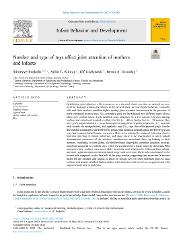| dc.description.abstract | Establishing joint attention with a caregiver on a physical object provides an optimal environment for language learning for infants. In the present study, we investigated whether 12-month-olds and their mothers establish higher quality joint attention interactions in the presence of fewer compared to more toys. As a secondary goal, we investigated how different types of toys affect how mother-infant dyads establish joint attention. In a five-minute free play setting, mothers and infants participated in either Five Toy (n = 48) or Twelve Toy (n = 33) groups. They were given organizational (i.e., toys that require arrangement of parts), responsive (i.e., toys that emit sounds via manipulation), and symbolic toys (i.e., toys that elicit pretend play). Results showed that compared to the Twelve Toy group, joint attention interactions in the Five Toy group were less frequent, lasted longer, were more likely to be initiated by maternal following than by maternal directing of infants’ attention, and more likely to be coordinated in which infants demonstrated awareness of the mothers’ simultaneous attentional focus by looking at their mothers, vocalizing, or turn-taking. We further found longer joint attention durations on organizational compared to symbolic toys, which were preferred to a lesser extent by the dyads. With responsive toys, mothers were more likely to initiate joint attention by following their infants’ attention. Joint attention interactions lasted longer and were more likely to be coordinated in the second half compared to the first half of the play session, suggesting that over time it became easier for the mothers and infants to settle on certain toys for more elaborate play. In sum, mothers and infants establish higher-quality joint attention with fewer toys in general and with organizational toys in particular. | en_US |
















